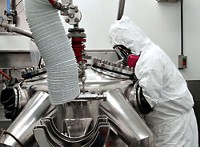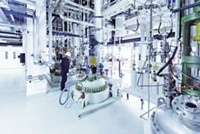Advertisement
Grab your lab coat. Let's get started
Welcome!
Welcome!
Create an account below to get 6 C&EN articles per month, receive newsletters and more - all free.
It seems this is your first time logging in online. Please enter the following information to continue.
As an ACS member you automatically get access to this site. All we need is few more details to create your reading experience.
Not you? Sign in with a different account.
Not you? Sign in with a different account.
ERROR 1
ERROR 1
ERROR 2
ERROR 2
ERROR 2
ERROR 2
ERROR 2
Password and Confirm password must match.
If you have an ACS member number, please enter it here so we can link this account to your membership. (optional)
ERROR 2
ACS values your privacy. By submitting your information, you are gaining access to C&EN and subscribing to our weekly newsletter. We use the information you provide to make your reading experience better, and we will never sell your data to third party members.
Business
Fine Chemicals: Executives See An 'Okay' Year Ahead
by Rick Mullin
January 10, 2011
| A version of this story appeared in
Volume 89, Issue 2

The pharmaceutical fine chemicals sector stands on firmer ground today than it did at the beginning of 2010, when major players speculated that the recession-triggered downturn had hit bottom. Indeed, business picked up in 2010, and manufacturers of drug intermediates and active ingredients are expressing optimism for 2011 tempered by a lowering of expectations.
COVER STORY
Fine Chemicals: Executives See An 'Okay' Year Ahead
“The good news is that requests for proposals in clinical development work appear to be going into 2011 moving in the right direction,” Cambrex CEO Steven M. Klosk says. “But whether projects will continue to be funded and have work done on them is still a bit of a question. We saw some improvement in 2010 and hope to see it continue in 2011.”
Customers that drew down inventories in 2009 began restocking last year, Klosk notes. Business may also be picking up as a result of a jump in prescriptions written for generic drugs, and he sees potential growth on the back of generic drug acquisitions by big pharma companies in high-growth emerging markets.
Aslam Malik, president of Ampac Fine Chemicals, says business has picked up slowly but steadily since 2009. “We are definitely seeing an increase in development work—projects in Phase I and Phase II clinical trials.”
He agrees with Klosk that customers are returning after working off inventory. “But people are still very conservative in ordering quantities,” Malik says. “Drug companies’ working capital is more controlled, and people are more cautious. It is nothing like it was in 2007 and ’08.”
Stefan Borgas, CEO of industry leader Lonza, expresses guarded optimism regarding a return to growth. “Although visibility continues to improve, volatility is persistent—mainly due to slow regulatory product approvals,” he said in announcing third-quarter 2010 earnings. “In addition, the macroeconomic environment remains challenging.”
Fine chemicals firms will continue to broaden their offerings, especially by adding final-dosage-form capability. Last year, Cambrex acquired a 51% stake in Zenara Pharma, an Indian finished-dose specialist, and Albany Molecular Research acquired the U.S. injectable-drug formulator Hyaluron. Lonza failed in an attempt to acquire formulator Patheon but claims it is still on the lookout for similar assets.
Consultant James Bruno, president of Chemical & Pharmaceutical Solutions, sees some reason for optimism in the market but identifies lingering instability. “A number of people I talk to aren’t convinced we’ve hit the bottom,” he says. “Pipelines are weak, which isn’t helping. Pharmaceutical industry consolidation isn’t helping.” And Bruno sees little in new-product pipelines to indicate a boost in business anytime soon. “2011 will be an okay year,” he says. “But don’t expect real growth until 2012.”




Join the conversation
Contact the reporter
Submit a Letter to the Editor for publication
Engage with us on Twitter